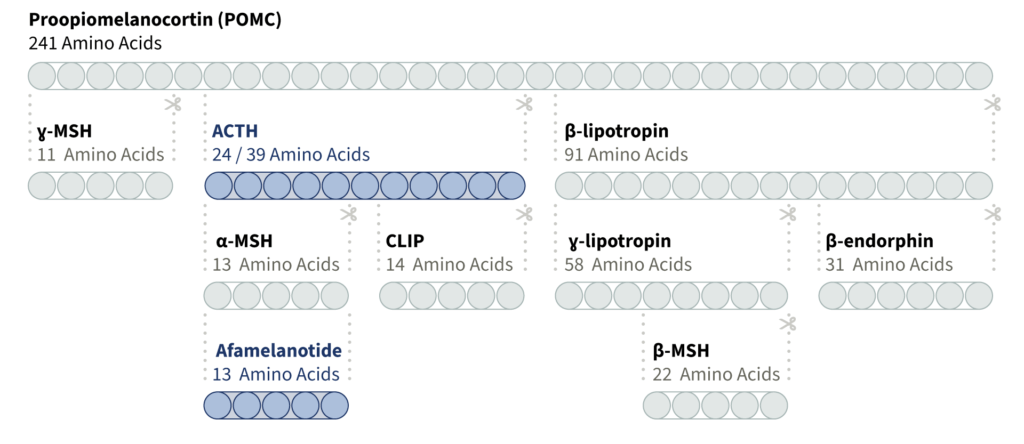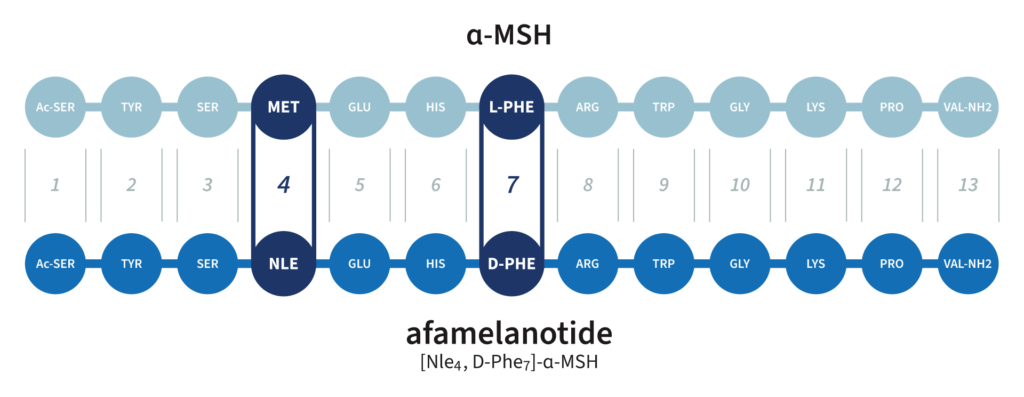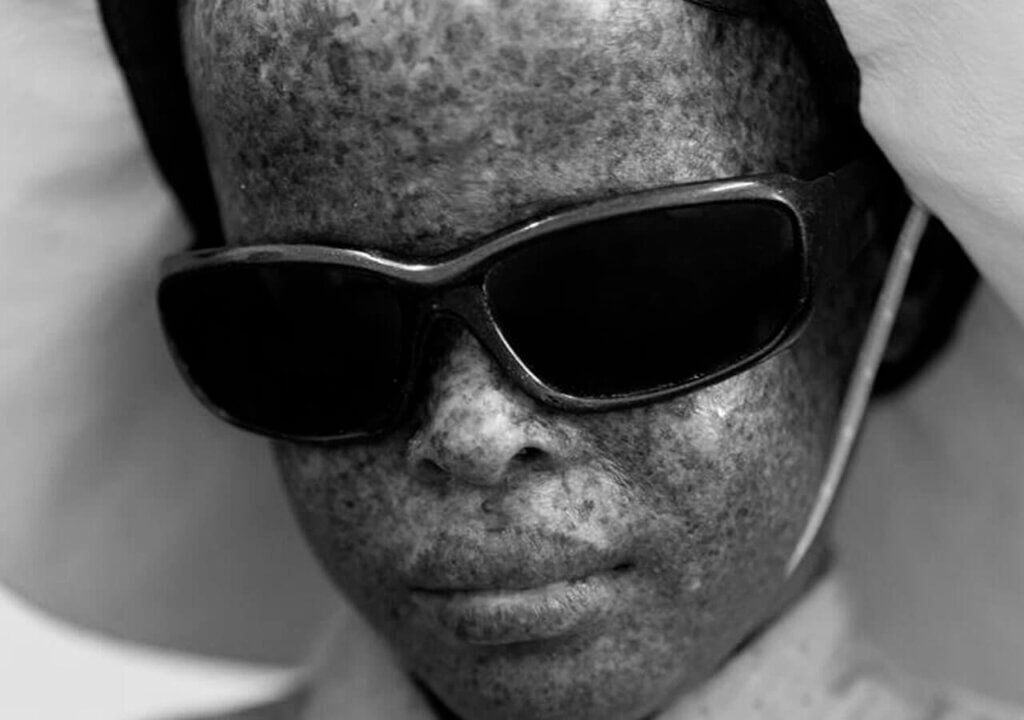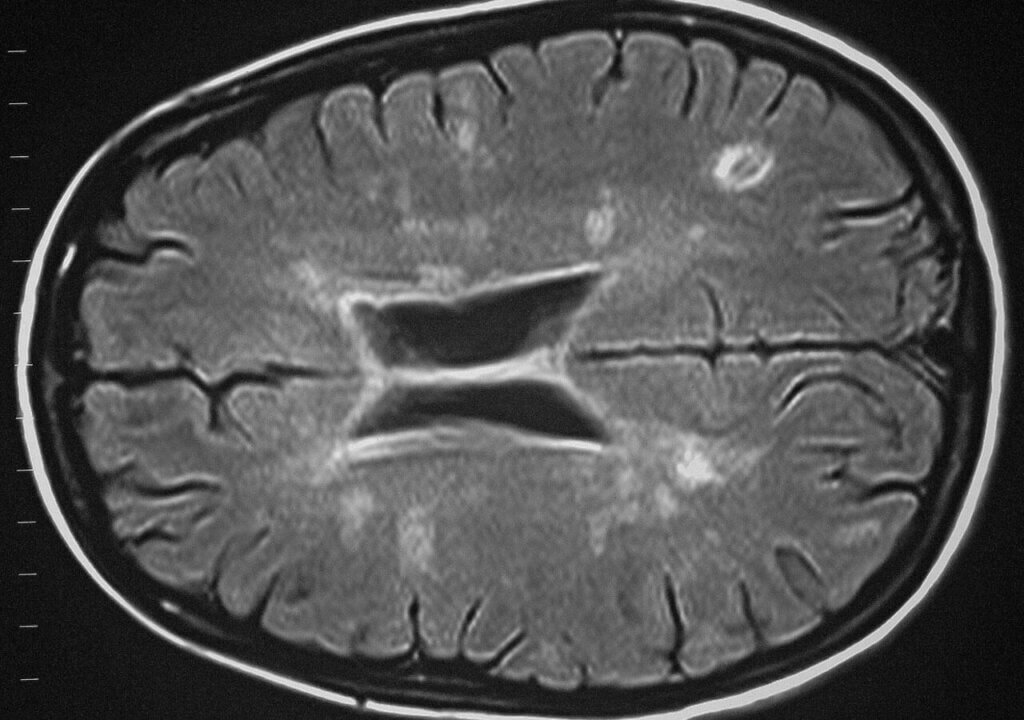
Melanocortin peptides, ACTH and α- β- γ-MSH derive from post-translational processing of POMC, which is also the precursor for opioid peptides and CLIP (corticotropin-like intermediate lobe peptide)
Melanocortins are a group of small protein hormones derived from proopiomelanocortin (POMC). These hormones modulate physiological activity in the body by binding with specific melanocortin receptors (MCRs) on cells across the body. Five MCRs have been identified: MC1R—MC5R.
POMC, the precursor molecule to all naturally occurring melanocortins, is widely expressed throughout the human body, although has very little biological activity. Cleaving POMC into smaller peptides produces melanocortins which are able to bind to receptors on cells and exert their effects. Since these peptides are tissue specific, the body can control the release of specific melanocortins from specific tissues to generate a biologically relevant effect.
The key POMC-derived peptides are α-MSH, beta-MSH, gamma-MSH and ACTH. All share a key sequence of four amino acids (-HFRW-) which allow them to bind to the various melanocortin receptors. α-MSH – the natural hormone of which afamelanotide is an analogue – is formed from the cleaving of ACTH and known to play a role in cells across the human body. Perhaps best known in humans is the role of α-MSH in dermal pigmentation: epidermal keratinocytes produce and release α-MSH in response to UV radiation exposure, with α-MSH then binding to MC1R on melanocytes to activate the synthesise of melanin. This process is known as melanogenesis. α-MSH is involved in a wide range of other functions in the body, including DNA repair, immunomodulation, anti‑inflammation, energy homeostasis, reproductive system functions, and exocrine gland secretion.
ACTH is the primary effector hormone mediating the HPA (hypothalamo‑pituitary-adreno) axis, which regulates a wide range of biological systems to meet day‑to‑day metabolic needs of the body. Released from the anterior pituitary gland, ACTH binds to MC2R on the adrenal glands, leading to release of the glucocorticoid cortisol. ACTH also binds to, and activates, all five known human melanocortin receptors, regulating immunomodulatory and neuroprotective activity.
β-MSH and γ-MSH are cleaved from the C-terminal and N-terminal ends of POMC, respectively. In humans β-MSH is thought to play a critical role in the regulation of body weight in humans via its effect on the hypothalamus, while γ-MSH is thought to regulate sodium balance and blood pressure through action on MC3R in the brain and kidneys.

Melanocortin peptides, ACTH and α- β- γ-MSH derive from post-translational processing of POMC, which is also the precursor for opioid peptides and CLIP (corticotropin-like intermediate lobe peptide)
| MC1R | MC2R | MC3R | MC4R | MC5R | |
|---|---|---|---|---|---|
| Expression | Anti-inflammatory cells Hair follicle Melanoma cells Melanocytes Periaqueductal grey Pituitary Skin glands Testes |
Adipocytes Adrenal cortex Skin |
Brain Gut Heart Placenta Testes |
Adipocytes Brain |
Adipose tissue Adrenal glands Brain Exocrine tissues Kidneys Leucocytes Lung Lymph nodes Mammary glands Muscles Ovaries Skeletal Testes Uterus |
| Function | Inflammation Pigmentation |
Steroidogenesis | Energy homeostasis Sexual behaviour |
Appetite regulation | Exocrine function |
| Agonist | α-MSH | ACTH | α- β- and γ-MSH | α- and β-MSH, ACTH | α-MSH, ACTH |
MCRs are found on cells across the body. Their known distribution and functions are illustrated on page 11.
MC1R is well-known for mediating adaptive tanning in human skin, although its activation also leads to regulation of a range of other effects, including anti-inflammation, DNA repair and immunomodulation. In addition to melanocytes and keratinocytes in the skin, MC1R is present on cells across wide range of tissues including the liver, brain and adrenal gland.
MC2R, uniquely for the MCR group, can be bound to and activated only by ACTH. MC2R is predominantly found in the adrenal glands where its action leads to cortisol release as part of the HPA axis, although like MC1R it is also present in a wide range of tissues, including skin, adipocytes, and bone.
MC3R functions include regulation of energy homeostasis, autonomic functions, feeding behaviours, and anti-inflammation. MC3R is normally expressed in the brain, immune cells, placenta, heart, thymus, gut and the eye.
MC4R has a broad range of functions that include energy homeostasis, feeding behaviour, thermogenesis, sexual function, cardiovascular function, anti-inflammatory, neuroprotection and pigmentation. MC4R is normally expressed in the brain, autonomic nervous system, spinal cord, immune cells, and the eye.
MC5R functions are still being researched, although evidence suggests that MC5R plays a key role in governing immune reaction and inflammatory response, regulation of sexual behaviour, thermoregulation, and exocrine secretion. MC5R is expressed ubiquitously in peripheral tissues including adrenal glands, liver, kidney, lung, lymph nodes, thymus, spleen, mammary glands, testis, ovary, uterus, skin, and exocrine glands.


A rare metabolic disorder of the haem biosynthesis pathway that causes severe, phototoxic reactions to visible and UV light.
Stimulates the production of eumelanin to provide systemic photoprotection from exposure to light and resulting protoporphyrin IX (PPIX) photoexcitation. This prevents phototoxicity in EPP, which is a result of a deficiency of the enzyme ferrochelatase (FECH) which causes PPIX accumulation in the body and skin.

A rare metabolic disorder of the haem biosynthesis pathway that causes both phototoxicity and acute attacks.
Stimulates the production of eumelanin to provide systemic photoprotection from exposure to light and resulting PPIX photoexcitation. This prevents phototoxicity in VP, which is a result of defects in the enzyme protoporphyrinogen oxidase (PPOX), which cause protoporphyrinogen IX accumulation (then oxidised to PPIX) in the body and skin.

A skin condition (believed to be auto-immune) resulting in a loss of pigment in the skin, causing profound psychological and social impact.
Stimulates melanocytes to produce eumelanin, which in conjunction with NB‑UVB results in melanocyte stem cell maturation and migration into vitiligo lesions, resulting in lesion repigmentation.

A rare genetic disorder which impairs the body’s ability to repair DNA damaged by exposure to light; leads to extreme risk of skin cancer.
Protects the skin from UV damage via multiple mechanisms, including the direct effects of increased melanin levels in the skin, antioxidative pathways and enhanced UV radiation repair mechanisms.

An acute life-threatening neurological dysfunction following a blockage of arterial blood flow.
Thought and evaluated on its supportive role in the reperfusion of brain tissue via vasodilatory effects, in addition to exerting anti-inflammatory effects and anti-oxidative effects within tissue affected by the stroke, potentially improving post‑stroke recovery.

A progressive neurodegenerative condition characterised by the death of dopaminergic neurons in the substantia nigra, accompanied by accumulation of alpha-synuclein (Lewy bodies).
Generates neuroprotective effects via attenuation of α-synuclein-induced dopaminergic neurotoxicity, as well as upregulating anti-inflammatory, anti-oxidative, and DNA repair pathways in a way which could slow disease progression.

A rare and serious seizure disorder in infants and young children, which can lead to developmental delay and epilepsy in later life.
Exerts antiepileptic properties through a combination of MC2R-activated steroidogenesis and MC3R/MC4R-mediated anti-inflammation in the central nervous system.

An auto-immune condition of the central nervous system which leads to impaired neurological function, including motor function.
Exerts immunomodulation by inhibiting the inflammatory effects of immune cells in the central nervous system, and generates an anti-inflammatory effect by reducing production of pro-inflammatory cytokines and inhibiting the activation of nuclear factor (NF)‑κB, the master driver of inflammation.